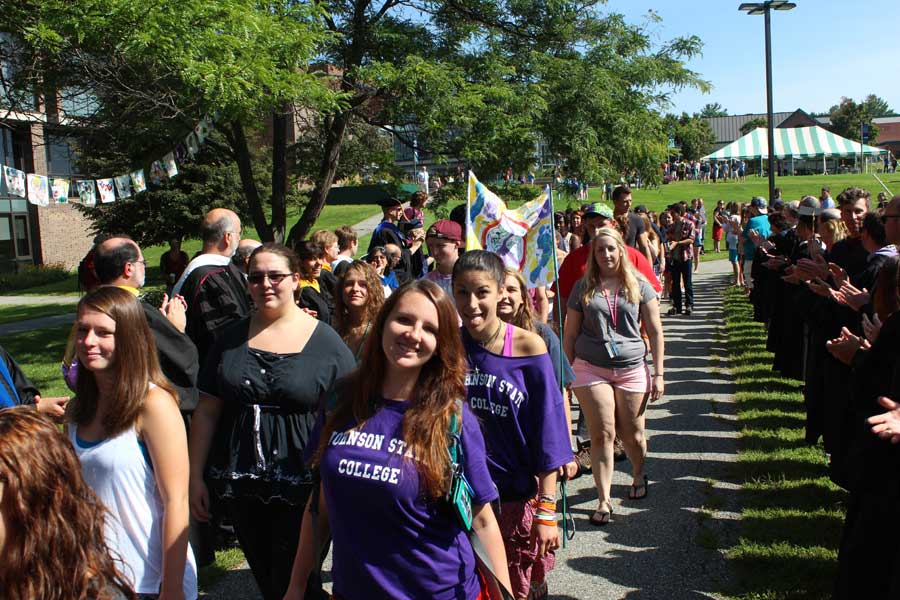New student enrollment up, total students down
The class of 2018 at Convocation
While the numbers are not yet official, this year’s preliminary enrollment figures reflect a mixed picture.
The incoming first-year class has seen a roughly 3 percent rise in the number of students as compared to last year, despite an overall declining trend in the total number of students.
The increase is attributed to the new early college program, which allows high school seniors to take their senior year off and go to Johnson in order to get college credit.
“It’s a new program,” said Penny Howrigan, associate dean of admissions and enrollment services. “The Legislature approved funding for this a year ago and this is our first year of allowing high school seniors to complete their senior year at Johnson State.They’re getting credit, and it’s paid for through the funding their school district would have received.”
20 students are involved in this program, all from high schools in surrounding counties.
Regarding overall enrollment, about 469 students are coming in this year, including the early college students, transfers, EDP, jump-start students and graduate students; however, these number may change by the middle of October.
This year hosts students from 11 different states and two countries: Turkey and New Brunswick, Canada. Out of the departments, business had the highest number of incoming students, followed by behavioral sciences, and then environmental and health sciences.
While there is a three percent increase in first-year students including the early college, there has been a declining trend in the population of students in Vermont graduating from high school.
“Overall, higher ed is a tough market, with declining demographics in the state of Vermont,” Howrigan said. “We have more colleges per capita than just about every other state.”
Declining demographics is not the only struggle that the college faces when trying to attract new students. Ranking second-to-last in the country in state support for public higher education, Vermont contributes approximately 17 percent of the revenues for the Vermont State Colleges, the remaining 83 percent derived from tuition. Consequently, the state colleges system is among the most expensive in the nation.
Based on the data taken on July 30 2014, compared to July 30 2013, this year has an overall 5.1percent decline in the student population. This includes -21 campus undergrads, including early college students; -66 EDP students; a gain of two graduate students; and a gain of eight non degree undergraduates.
Vermont is also one of the few states in New England that allows public funds for Vermont students to go out of state, via VSAC, furthering to the lack of funding for the colleges. Yet Johnson is trying to reduce the burden on students through institutional scholarships.
“We’ve really tried to make an investment in increasing our institutional aid,” Howrigan said. “So usually it’s a combination of the student, parent, federal government, state and Johnson State, so hopefully that can help students in trying to minimize the student loans they have to borrow.”
This past year, the admissions office has tried many new strategies to bring students in. “We tried to personalize the visits even more,” Howrigan said. “So when prospective students call in we try to find out their major, what they think they want to study, try to arrange a meeting with a faculty member, because sometimes that can make all the difference.”
In September, 2013, admissions started a call center to continuously check on potential students throughout the admissions process and invite them to open houses and other events.
As Johnson deals with declining enrollment, the administration is coming up with other strategies to attract more students over the coming years.
“Another opportunity for us that other schools don’t have is the External Degree Program,” said Professor of Business and Economics James Black, who is also a member of the college’s economic task force, convened by President Murphy to study JSC’s economic issues.
“There are 90,000 Vermonters who have some college but no degree,” said Black. “This external degree program is set up so that people who are working and have families don’t have to be on campus to get on campus to get their degree.”
Retention is another step to improve the number of students. Black said this involves making an individual connection with each student. Approximately 63.5 percent of first-year students return to Johnson as a sophomore. Majors that have high retention rates, such as hospitality and tourism or technical theater, are believed to reflect that their students have come to the college specifically for the skills necessary to get a job.
“That’s part of the long-term solution to enrollment and retention,” Black said. “To provide programs students see as valuable in the sense that it will get them jobs.”
Ben Simone joined the Basement Medicine Staff in Spring 2014, assuming the position of staff reporter.




